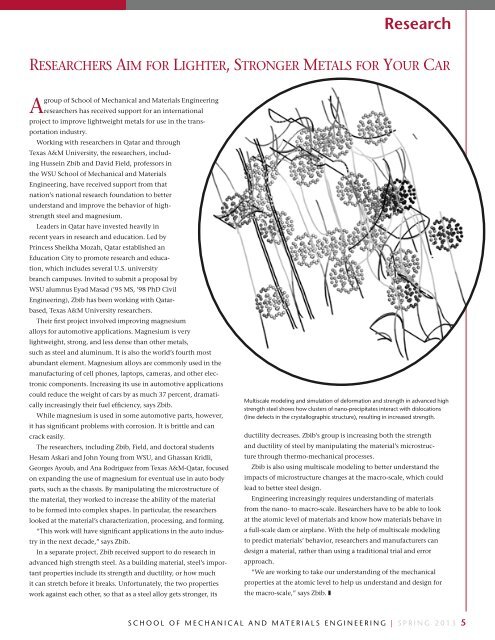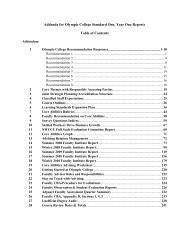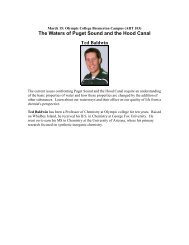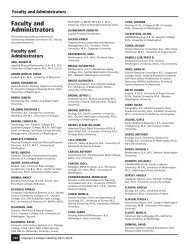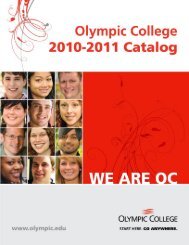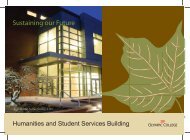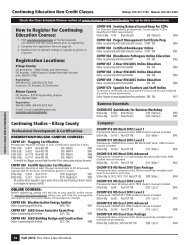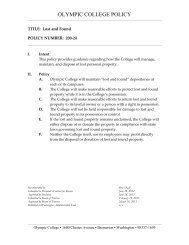Full MME Newsletter - Washington State University College of ...
Full MME Newsletter - Washington State University College of ...
Full MME Newsletter - Washington State University College of ...
Create successful ePaper yourself
Turn your PDF publications into a flip-book with our unique Google optimized e-Paper software.
Research<br />
Researchers Aim for Lighter, Stronger Metals for Your Car<br />
group <strong>of</strong> School <strong>of</strong> Mechanical and Materials Engineering<br />
A researchers has received support for an international<br />
project to improve lightweight metals for use in the transportation<br />
industry.<br />
Working with researchers in Qatar and through<br />
Texas A&M <strong>University</strong>, the researchers, including<br />
Hussein Zbib and David Field, pr<strong>of</strong>essors in<br />
the WSU School <strong>of</strong> Mechanical and Materials<br />
Engineering, have received support from that<br />
nation’s national research foundation to better<br />
understand and improve the behavior <strong>of</strong> highstrength<br />
steel and magnesium.<br />
Leaders in Qatar have invested heavily in<br />
recent years in research and education. Led by<br />
Princess Sheikha Mozah, Qatar established an<br />
Education City to promote research and education,<br />
which includes several U.S. university<br />
branch campuses. Invited to submit a proposal by<br />
WSU alumnus Eyad Masad (’95 MS, ’98 PhD Civil<br />
Engineering), Zbib has been working with Qatarbased,<br />
Texas A&M <strong>University</strong> researchers.<br />
Their first project involved improving magnesium<br />
alloys for automotive applications. Magnesium is very<br />
lightweight, strong, and less dense than other metals,<br />
such as steel and aluminum. It is also the world’s fourth most<br />
abundant element. Magnesium alloys are commonly used in the<br />
manufacturing <strong>of</strong> cell phones, laptops, cameras, and other electronic<br />
components. Increasing its use in automotive applications<br />
could reduce the weight <strong>of</strong> cars by as much 37 percent, dramatically<br />
increasingly their fuel efficiency, says Zbib.<br />
While magnesium is used in some automotive parts, however,<br />
it has significant problems with corrosion. It is brittle and can<br />
crack easily.<br />
The researchers, including Zbib, Field, and doctoral students<br />
Hesam Askari and John Young from WSU, and Ghassan Kridli,<br />
Georges Ayoub, and Ana Rodriguez from Texas A&M-Qatar, focused<br />
on expanding the use <strong>of</strong> magnesium for eventual use in auto body<br />
parts, such as the chassis. By manipulating the microstructure <strong>of</strong><br />
the material, they worked to increase the ability <strong>of</strong> the material<br />
to be formed into complex shapes. In particular, the researchers<br />
looked at the material’s characterization, processing, and forming.<br />
“This work will have significant applications in the auto industry<br />
in the next decade,” says Zbib.<br />
In a separate project, Zbib received support to do research in<br />
advanced high strength steel. As a building material, steel’s important<br />
properties include its strength and ductility, or how much<br />
it can stretch before it breaks. Unfortunately, the two properties<br />
work against each other, so that as a steel alloy gets stronger, its<br />
Multiscale modeling and simulation <strong>of</strong> deformation and strength in advanced high<br />
strength steel shows how clusters <strong>of</strong> nano-precipitates interact with dislocations<br />
(line defects in the crystallographic structure), resulting in increased strength.<br />
ductility decreases. Zbib’s group is increasing both the strength<br />
and ductility <strong>of</strong> steel by manipulating the material’s microstructure<br />
through thermo-mechanical processes.<br />
Zbib is also using multiscale modeling to better understand the<br />
impacts <strong>of</strong> microstructure changes at the macro-scale, which could<br />
lead to better steel design.<br />
Engineering increasingly requires understanding <strong>of</strong> materials<br />
from the nano- to macro-scale. Researchers have to be able to look<br />
at the atomic level <strong>of</strong> materials and know how materials behave in<br />
a full-scale dam or airplane. With the help <strong>of</strong> multiscale modeling<br />
to predict materials’ behavior, researchers and manufacturers can<br />
design a material, rather than using a traditional trial and error<br />
approach.<br />
“We are working to take our understanding <strong>of</strong> the mechanical<br />
properties at the atomic level to help us understand and design for<br />
the macro-scale,” says Zbib. ❚<br />
School <strong>of</strong> Mechanical and Materials Engineering | Spring 2013 5


